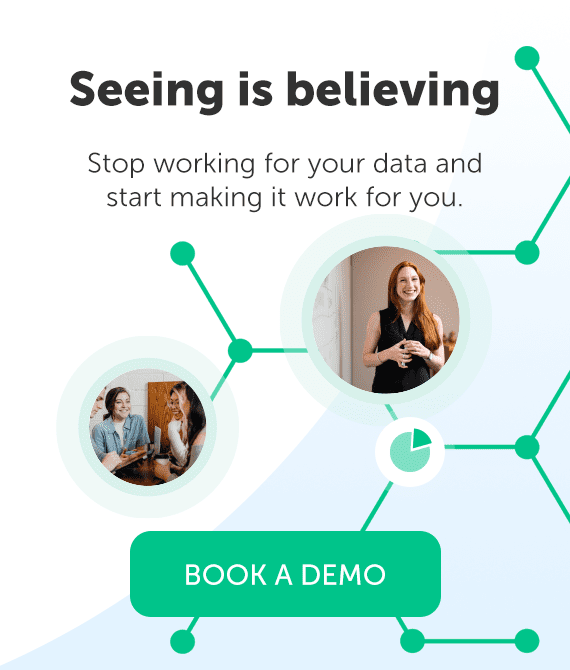Big data. Information technology. Business intelligence. You’ve heard all of the big data and analytics buzzwords. But it’s not all buzz. It’s the new reality. There’s a difference between data, information, and intelligence. And if you want to make more sophisticated decision-making and differentiate your organisation, you need to know how they differ and how they work together.
81% of executives said their organisations have increased their data and analytics investments over the past two years. Why? Data management solutions enable better decision making, improve operational efficiencies, and increase competitive advantages.
However, when investing in data management, predictive analytics, or business intelligence solutions, most firms make a critical error: They don’t know which pieces of knowledge they need. It isn’t until after they’ve invested in an intelligence solution that they realise the tool is useless without better data.
Data vs. Information vs. Intelligence
Data, information, and intelligence have major implications for your business. And, yes, you need all three to enable better decision-making and strategy.
What is Data?
Data in its rawest form is a recorded truth from a point in time. It’s a snapshot of an event. That event might be a conversation, an email, or an interaction with your company’s website. Data is the collection of outcomes from those events that is then recorded in a quantifiable way, so businesses can easily review them. They’re statements of fact and cannot be contested.
What is Information?
Information is a simplistic way of bringing data together. You will have information, not data, when you take data from an event and put it into a narrative. It’s the context of data helping you answer questions such as:
- How many clients operate in EMEA?
- What is our churn rate?
- How long is our sales cycle?
The answers to those questions are what create information. It’s all about turning data points into something that informs you about your business.
What is Intelligence?
Intelligence takes it a step further and uses information to drive decisions. Instead of telling a story (like information does), intelligence paints a picture. For example, if you’re selling to more people in EMEA, intelligence answers why that might be. Intelligence will look at the number of events, ad spend, or marketing campaigns EMEA clients receive and compare them to other clients in other regions and markets.
Through this analysis, you might see that there are a greater number of client interactions (events, emails, or meetings) in the EMEA region and deduce that you need to do the same in North America to bring sales up.
How Data, Information, and Intelligence Work Together
Data, information, and intelligence are all a part of the same continuum. Yes, they’re different in definition and function, but equal in importance for accurate decision-making. When constructing a solution to a business problem, you need to have all three elements guiding your strategy. Miss one, and you’re using incomplete data or information to form strategic decisions, which could have catastrophic effects on your bottom line.
The Starting Point
If intelligence is your end goal (which it should be), you need to have clean, accurate data first and foremost. With that in mind, you need to collect data from your operational environments across your organisation, both internally and externally. You never know what insights will transpire, and without data, the continuum falls apart.
Filling in the Gaps
Without the context information provides, data is meaningless. As such, you need to ask critical questions of the data you’ve gathered to identify the “who, what, where, when, how” of your business.
Completing the Continuum
To complete the knowledge continuum, you need to uncover why results are happening to make more informed business decisions. Tools like Introhive’s relationship intelligence automation platform passively collect relationship data in the background so you don’t have to. It identifies and records your firm’s network of contacts, emails, calls, meetings, social media activity, transactions, and more so you have a full understanding of your firm’s relationships and how strong they are.
With the data collected, the platform analyses that data to turn it into information and intelligence that can be accessed through reporting dashboards and Pre-Meeting Intelligence Briefings. Automation tools also remove human error from the data entry process and flag duplicate data points to ensure that your CRM data and client insights are accurate, complete, and always up-to-date.
Business Intelligence is Easier to Obtain Than You Think
Business intelligence isn’t just for large corporations. Organisations often get scared of big data, how it operates, and the associated costs. However, SaaS technology has made it far cheaper and accessible to collect data, create information, and extract intelligence since there are no labour or server costs associated with them.
Don’t let misconceptions hold your business back. Unlock the power of data, information, and intelligence with Introhive’s relationship intelligence automation platform. Our cutting-edge solution passively collects and analyses relationship data, turning it into actionable insights that drive growth and efficiency.
Ready to transform your decision-making process and boost your business strategy? Discover how Introhive can empower your organisation by requesting a demo of our relationship intelligence automation platform today. Start your journey towards smarter, data-driven decisions and a more successful future.
FAQ on Data vs. Information vs. Intelligence
What are the key differences between data, information, and intelligence?
The key differences between data, information, and intelligence lie in their purpose and application. Data consists of raw, unprocessed facts and figures, such as sales transactions or website visits. Information is created when data is processed and organised to provide context and meaning, answering specific questions about the business. Intelligence takes it a step further by analysing this information to uncover deeper insights, patterns, and trends, which then inform strategic decisions and drive business actions.
Why is clean and accurate data essential for intelligence?
Clean and accurate data is essential for intelligence because it serves as the foundation for the entire knowledge continuum. Reliable data ensures that the information derived from it is trustworthy and meaningful, which in turn leads to accurate and actionable intelligence. Without clean data, the insights generated could be flawed, leading to poor decision-making and potential negative impacts on the business. Additionally, clean data improves efficiency by reducing the need for extensive data cleaning, allowing analysts to focus on extracting valuable insights.
How does the knowledge continuum of data, information, and intelligence work together?
The knowledge continuum works together by transforming raw data into actionable intelligence through a systematic process. It begins with the collection of data from various sources. This data is then processed and organised to create information, which provides context and answers specific business questions. Finally, this information is analysed to generate intelligence, offering deeper insights and guiding strategic decisions. This continuum ensures that businesses can make well-informed decisions based on comprehensive and accurate insights, leading to better outcomes and sustained success.





